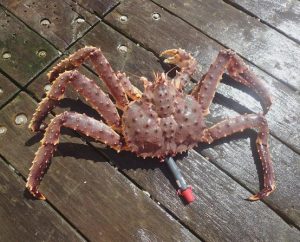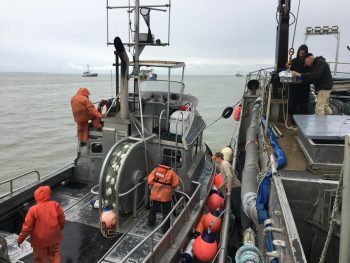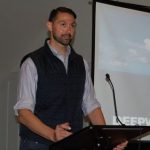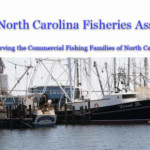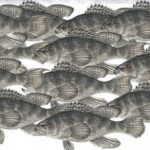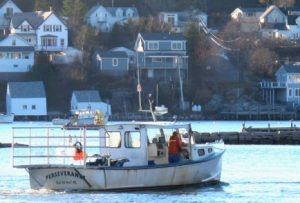Tag Archives: Bristol Bay
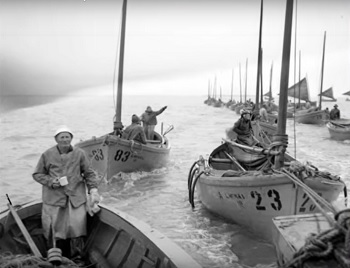
Frontiers 190: Iron Men of Bristol Bay
Alaska is a place where much of its history is still fresh, yet with so many stories on the verge of disappearing forever. Such is the case with the double ender sailboat, pushed by the wind and the tides across Bristol Bay in pursuit of salmon. For more than 60 years, they were the workhorses of the canneries that brought in fishermen from all over the world in big sailing ships to work the boats and pull in nets, heavy with sockeyes, all by hand. The sailboats may have been beautiful, but they were dangerous. And although motorized boats appeared on the market in the 1920s, Bristol Bay fishermen weren’t allowed to use them for commercial catches until the 1950s. Video, >click to read< 11:22
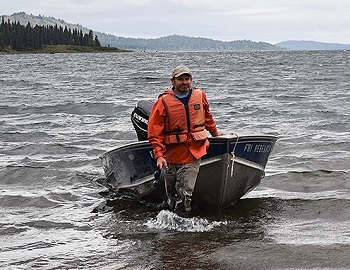
Meet the salmon scientist at the center of the Pebble fight
Beneath the steady static of rain on a tin roof, University of Washington aquatic ecologist Daniel Schindler made some soup. On a clear day, he’d be wading through thousands of hump-backed, hooked-jawed sockeye that turn the pristine waters of southwestern Alaska red every year. Schindler has put himself in the middle of the two-decade fight over the Pebble mine, a proposal to build one of the world’s largest gold and copper mines roughly 100 miles east of Lake Nerka. >click to read< 20:01
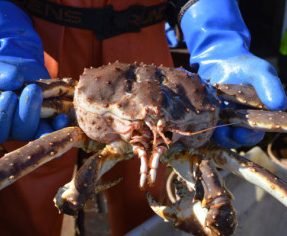
Red King Crab Quota Down 12% As Stock Trends ‘Toward Fishery Closure Thresholds’
Commercial fishing opens Tuesday, Oct. 15 for Bristol Bay red king crab. This season, the declining population has forced managers to set the total allowable catch (TAC) at 3.8 million pounds. That number is 12 percent lower than last year, as well as the lowest since the fishery was rationalized in 2005. Even if fishermen catch all of the TAC, it’ll be the smallest harvest since 1982. “This is not good news,” said biologist Ben Daly of the Alaska Department of Fish and Game. “We’re trending toward fishery closure thresholds.” >click to read< 15:11
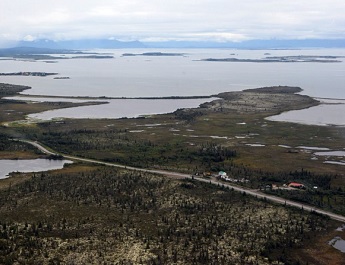
We ask Sen. Murkowski to let the Pebble process play out
Perhaps you have seen our ads thanking Sen. Lisa Murkowski for standing up for the permitting process for Pebble. The theme of our ads is “we need jobs” and “we want hope.” While the coastal communities in our region see some benefits from the short commercial fishing season, many in our home communities do not. Recently, several of our Bristol Bay leaders took to these pages pushing Sen. Murkowski to more be more aggressively involved in the permitting process. We support Sen. Murkowski staying informed and engaged about the Pebble issue. >click to read< 09:53

Fishermen catch 2 billionth sockeye salmon in Bristol Bay this year, since record-keeping began
This year, during the fishery’s second largest harvest on record, Bristol Bay commercial fishermen hit another historic number: the 2 billionth sockeye salmon caught by commercial fishermen since record-keeping began in the late 1800s. “It wasn’t supposed to happen this fast, but the last couple of seasons had huge returns,” said Nushagak/Togiak Area Management biologist Timothy Sands. >click to read< 10:24
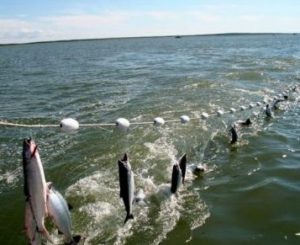
Preliminary summary gives Bristol Bay highest exvessel value ever
After reviewing preliminary data from the season, Alaska Department of Fish & Game says that 2019 appears to be have produced the highest exvessel value of all time at $306.5 million. That means the money paid to boat captains as they unloaded their catches at dock was the highest ever, though the numbers don’t include adjustments for icing, bleeding, or production bonuses. The ADF&G summary also shows that the sockeye fun of 56.5 million >click to read< 10:46
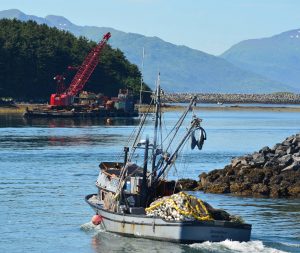
Sockeye harvest breaks all-time top 5; pinks picking up
The 2019 salmon season has seen plenty of fish return to the state, but far from evenly across regions. As of Sept. 10, commercial fishermen across Alaska have landed 198.4 million salmon of all five species, about 8 percent less than the preseason forecast of 213.2 million. Most of that shortfall is in pink and chum salmon, which haven’t delivered on their forecasts so far, but a surplus of sockeye salmon helped make up for some of that gap. Statewide, commercial fishermen have landed more than 55.1 million sockeye, about 9 percent more than last year and 5 million more than the preseason forecast. >click to read< 07:40
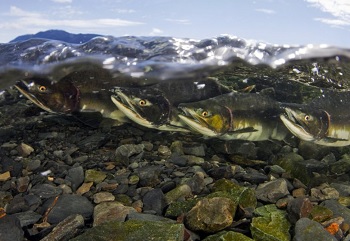
Bristol Bay Salmon Are in Hot Water
I’ve worked as both a journalist and a commercial fisherman for over a decade, participating in more than a dozen fisheries from Southern California to the western Gulf of Alaska. I’ve seen booms and busts over the years, and this summer the fishing in Bristol Bay was booming. Estimates say 56.3 million salmon returned to the bay’s rivers. While down from 2018’s record-breaking runs, with 62.3 million fish, Bristol Bay has so far bucked the trend of declining salmon runs seen in other regions. But all is not well. by Nick Rahaim >click to read< 09:43
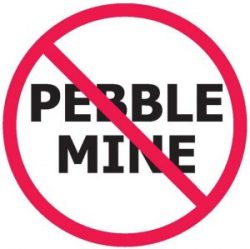
Pebble Mine: Commercial Fishermen, Indigenous People Unite to Fight Mine in Alaska
The Pebble Mine is a large deposit of gold, copper and molybdenum located at the headwaters of Bristol Bay. The deposit was first discovered in the 1980s and multinational corporations began seriously pursuing its development in the 2000s. Those who want to develop the mine say it will create high-paying jobs for locals and reduce America’s dependence on foreign countries for the provision of raw materials. Opponents say toxic discharge from the mine could foul the home of the world’s largest salmon run, bankrupting the mammoth fishing industry and destroying the local ecology. “It’s one of the unique things about this whole fight,”,,, >click to read< 10:40
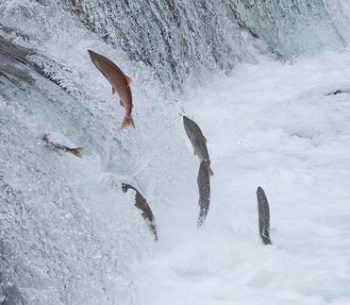
EPA kills proposed Obama-era Pebble mine ‘veto’
The Environmental Protection Agency announced Tuesday it will reverse an Obama-era decision to block a controversial Alaska mine project. “After today’s action EPA will focus on the permit review process for the Pebble Mine project” Region 10 Administrator Chris Hladick said in a statement. While the EPA is withdrawing the 2014 determination, which it wrote “was issued preemptively and is now outdated,” the withdrawal does not constitute an approval of the permit application or a determination in the permitting process. “Instead, it allows EPA to continue working with the Corps to review the current permit application and engage in the National Environmental Policy Act (NEPA) process,” the statement reads. >click to read< 19:19
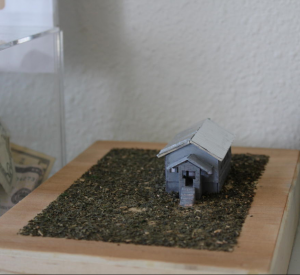
Remembering 1919, one hundred years later, the Spanish flu hit Bristol Bay, and the salmon run collapsed.
“The Spanish flu arrived to Alaska in 1918 and devastated the population.,, People thought it had run its course that winter, but when cannery ships arrived in 1919, people were quickly becoming sick, it was evidenced it was influenza, and it devastated not just the Native population, it killed many people who lived here, but it really changed the demographics in this region.” Within weeks of the start of the 1919 fishing season, hundreds of cannery workers and locals were infected with the Spanish flu. The virus wiped out most of the adult population in many villages around Bristol Bay, leaving behind dozens of orphaned children. One of the communities most changed by the outbreak was Naknek. >click to read< 22:05
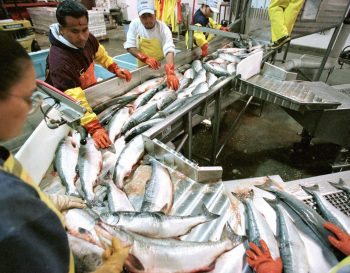
Bristol Bay sockeye harvest blowing away forecast once again
Bristol Bay is approaching the record for sockeye salmon harvest once again. As of July 21, fishermen in Bristol Bay’s five districts had harvested just more than 42 million salmon. More than 41.5 million of those were sockeye, according to the Alaska Department of Fish and Game; that’s already more than the 41.3 million sockeye harvested in 2018, the second-largest harvest on record. The largest harvest on record, which occurred in 1995, still stands at 44.2 million sockeye. >click to read< 09:40
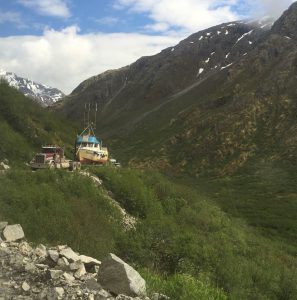
On the way to Bristol Bay, a sunken boat buoys a friendship
My two friends and I have been talking about the zombie apocalypse. It’s our shorthand for when things go very, very wrong.,,, Last week in a brief moment amidst chaos I remarked to her, “Well, here we are in the zombie apocalypse. I’m glad I’m here with you.” We were standing in the cabin of the Catch 22, the commercial fishing vessel belonging to Adri and her husband Luke. We had been accompanying him as he headed out to Bristol Bay for the summer when the boat hit a rock in a very shallow section of the Kvichak River and sank. >click to read<10:27

OPINION: Bristol Bay’s future is in our fish and natural resources
We are just a few of the many young adults whose livelihoods depend on the clean water and pristine land that has sustained the people of Bristol Bay since time immemorial. As Pebble tries to sell Alaskans on its sham of a mine plan, this time by focusing on jobs, we want to clear something up: We oppose Pebble Mine. We want to protect the environment that provides the resources to sustain our communities and families, and we won’t stop until our work is done. >click to read<11:17
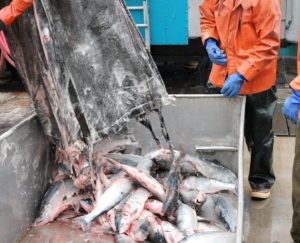
Pebble backs fishermen lawsuit to halt Bristol Bay seafood association’s funding for anti-mine groups
Six Bristol Bay commercial fishermen are suing a regional seafood association they belong to, challenging over $250,000 in contracts it made with groups that advocate against the proposed Pebble Mine. The Pebble Limited Partnership confirmed it is paying for the litigation. The plaintiffs — Trefim Andrew, Tim Anelon, Gary Nielsen, Henry Olympic, Abe Williams and Braden Williams — are challenging the Bristol Bay Regional Seafood Development Association’s recent contracts with SalmonState and the United Tribes of Bristol Bay. Both SalmonState and UTBB are ardent Pebble opponents. >click to read<16:01
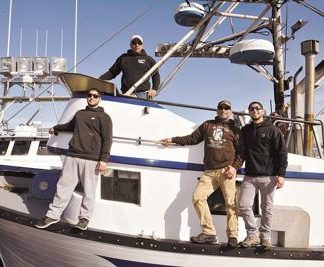
Monterey Bay fishermen catch salmon as far away as Alaska. A proposed copper mine there poses a local threat.
Tom DiMaggio is 96 years old and blessed with a full head neatly combed white hair and a warm handshake. A fisherman for his whole career, he’s been retired for over 20 years and remains a vibrant member of the fishing community – only these days, the community is far from the dock and instead gathers at the East Village Coffee Lounge in Monterey to while away weekday mornings, sipping espresso and swapping stories.,,Commercial fishing is an unpredictable profession in many ways, though the two greatest uncertainties are how many fish are caught and how much those fish sell for. The nature of the job means many fishermen want to surround themselves with a crew they can trust, which often means family. Ask the East Village table of old-school fishermen how they got started, and they all have a similar answer:, >click to read<14:00
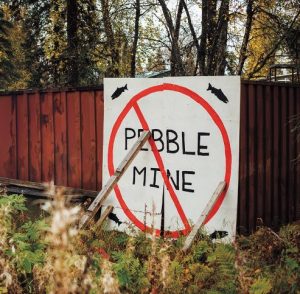
The Former Clintonite Trying to Build the Country’s Most Controversial Mine
Tom Collier is buckled into the back of a six-seat AS350 Helicopter, racing over the lowland bluffs of southwest Alaska. Clad in a black Helly Hansen jacket and baseball hat bearing the word Pebble, he doesn’t exactly look at ease, though he’ll later claim otherwise. When the chopper banks south, he reaches awkwardly for the ceiling, desperate for something to grab. Soon we pass over the Newhalen River, a rushing white torrent, then cut into the rolling hills of the Nushagak and Kvichak river drainages. The two waterways are among the wildest left in the United States , and their watersheds form a sea of tundra sedge and skinny water that produces about half of the sockeye salmon in Bristol Bay, Alaska. >click to read<11:36

One king salmon worth more than a barrel of oil to AK fishermen; Updates for 2018/19
Salmon stakeholders are still crunching the numbers from the 2018 season, which up front has two distinctions: it ranks as one of the most valuable on record to fishermen at nearly $596 million, and at just over 114 million salmon, it’s one of the smallest harvests in 34 years. A breakdown by the McDowell Group shows the sockeye harvest was the second most valuable in 26 years; the chum catch was the third most valuable since 1975. Audio report, >click to read<17:06
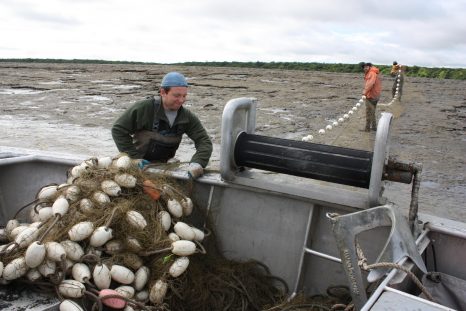
It’s Official! 62.3 million: Bristol Bay’s 2018 salmon season the largest ever
It is official; 2018 was the largest sockeye salmon run to Bristol Bay on record, and the Alaska Department of Fish and Game has records dating back to 1893. The 2018 Bristol Bay Season Summary, which ADF&G released in September, reiterates the records this year’s run broke. To start with, the total run to Bristol Bay this summer was 62.3 million sockeye. That is 21 percent above the preseason forecast of 51.3 million fish.,, The ex-vessel value also broke a record – $281 million for all salmon species. >click to read<15:02

Bristol Bay salmon pay day is biggest on record on largest sockeye run since 1893
It’s a record breaking pay day for salmon fishermen at Bristol Bay, topping $280 million at the docks. That’s 242 percent above the 20 year average – and the number will go higher when bonuses and post season adjustments are added in. Bay fishermen averaged just under $215 million at the docks last year. According to a summary by the Alaska Dept. of Fish and Game, the 2018 sockeye salmon run Bristol Bay of 62.3 million fish was the biggest since 1893, and nearly 70 percent above the 20 year average. It also was the fourth consecutive year that sockeye runs topped 50 million fish. Audio report, >click to read<16:30

Alaska’s 2018 commercial salmon harvest 30 percent below forecast, yet some fisheries have boomed
The statewide commercial salmon harvest is about 31 percent below the preseason forecast, the Alaska Department of Fish and Game said in a statement Thursday. The 2018 season, it said, “has been unusual.” Preliminary numbers show a statewide commercial salmon harvest of about 103 million fish so far. That’s subject to change, because the fishing season isn’t completely over yet. Fish and Game’s forecast in March projected a total statewide harvest of 147 million fish. >click to read<08:03
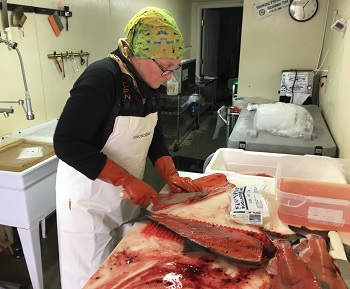
Small processors carve out a market in Bristol Bay
Standing in a shipping container that’s been converted into essentially a salmon butchery. Sandy Alvarez is filleting a sockeye. People regularly admire her technique but she said the secret behind it is practice. “Well you know people who comment they wish they could do that I usually laughingly tell them. ‘Try doing 1,500 fish for 10 years you probably can!’” Almost a decade ago Alvarez and her husband, a commercial fisherman, set up a little processing plant near their summer home in Naknek. Alvarez’s husband fishes for sockeye and drops off a bit of his catch to his wife who then processes it. Then he sells the rest of his salmon to a larger seafood company. That is pretty typical for small seafood processors in the region. >click to read<22:20
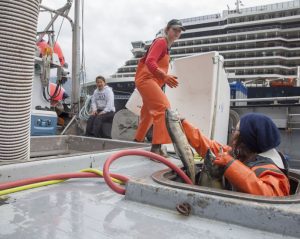
The mysterious case of Alaska’s strange sockeye salmon returns this year
There’s something unusual going on with the sockeye salmon runs returning to Alaska this year. In some places — like Bristol Bay — the runs are strong. In others, like the Copper River or the Kenai River they’re unexpectedly weak. In some places, there are sockeye that are unusually small. In others, sockeye of a certain age appear to be missing entirely. It’s a mystery. In Southeast Alaska, one of the first Fish and Game staffers to notice an unusual trend was Iris Frank, a regional data coordinator and fisheries technician. Frank’s lab is on the first floor of Fish and Game’s Douglas Island office that looks like it hasn’t changed much in the 32 years since she got there. >click to read<18:06

After a long wait, Ugashik fishermen’s patience paid off
Fishermen in Ugashik Bay are used to their sockeye salmon to showing up late in Bristol Bay’s salmon season. This summer’s salmon season was especially trying, but for some, the wait was worth it. Conrad Day and his crew tow a net into the Ugashik River in preparation for the incoming high tide. He explained, “Now we’ll just wait on the switch, cause when the water floods the fish come with it. It’s like a free ride upriver.” Things are quiet out on the water tonight, but a few days ago the river would’ve been full of fellow set netters preparing for the evening sockeye run. >click to read<17:12
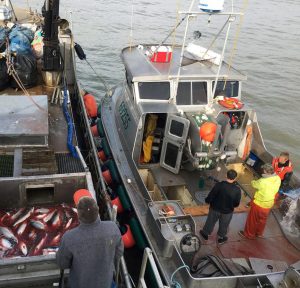
How much Bristol Bay processors will pay for salmon
The question on every Bristol Bay fisherman’s mind at this point in the season is base price: How much cash am I going to get for my salmon? A few Bristol Bay processors said they’re still waiting on their corporate headquarters to release prices, but here’s what we do know as of Tuesday: On Monday, Copper River Seafoods raised its price from $1.30 to $1.70 per pound for chilled, bled and separated sockeye only. Kings larger than 11 pounds bring in $3 per pound, and smaller kings go for $2 a pound. Copper River is paying 80 cents per pound on silvers, 45 cents per pound on chum and 30 cents per pound for pinks. Trident Seafoods is paying,,, >click to read<11:02
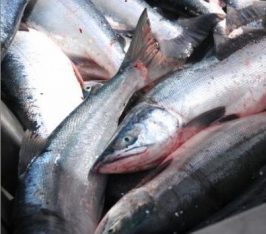
Bristol Bay sockeye harvest breaking records as other districts suffer
The Nushugak District in Bristol Bay is experiencing an all-time record harvest of sockeye salmon as other districts across Alaska suffer poor returns. “Last year the Nushagak set an all-time record of 12.3 million fish for the year, I just got off the phone [on Friday] with the manager and he expects that record to be broken today,” said Art Nelson, a spokesperson for commercial fisheries at the Alaska Department of Fish and Game. “And there are more fish to come.” Other districts across Alaska have been struggling with poor sockeye harvests. >click to read<08:44

One month into the season, Bristol Bay halibut fishermen harvest a quarter of the quota
Bristol Bay fishermen have landed 8,700 pounds of halibut so far. This year’s quota for area 4-E is 33,900 pounds, significantly less than last year’s quota of 58,800 pounds. “It is a reduction,” said Gary Cline, the regional fisheries director at BBEDC. “It’s basically because there appears to be less halibut abundance in the Pacific, not just in area 4-E, but stretching down to southeast and throughout the Bering Sea. And, because of this concern, the regulatory agencies have adopted a more restrictive catch limits for 2018.” >click to read<08:22
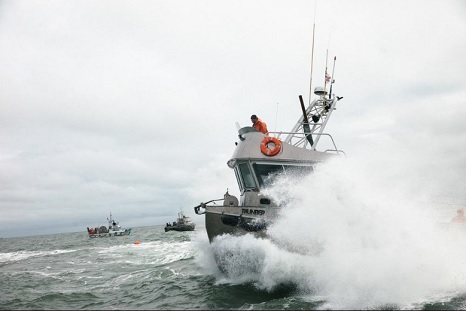
The story of a boy, a boat, and love at first bite
Kara Berlin was living the aspirational life of any young urbanite. She was raised in Washington by parents who took her outside to play. She went to college. She moved to Idaho to work a corporate job where terms like “fast track” and “executive management potential” littered her quarterly reviews. But then the economy happened and her employer closed up shop. In Sandpoint, she met Taran White. White had a lot of free time because it wasn’t salmon season. Berlin had a lot of free time because she was unemployed. So they took off to Asia to drink cheap cocktails, get $5 massages and fall in love. They wrote a business plan along the way, too. >click to read<18:04






